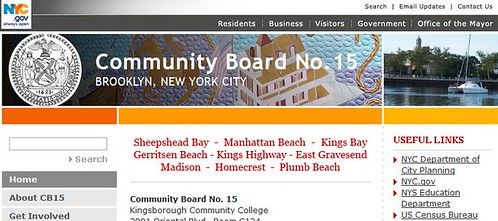Hey CB15, Join Us in the 21st Century!

The Internet is a wonderful thing. Through a series of tubes citizens have been given tools to consume unprecedented amounts of entertainment. We have searchable, indexed digital libraries of substantive research and informational flotsam and jetsam. We can network and tweet and post and putter all hours of the day. And yet, our local political entities have done nothing to use those tools to facilitate real world community.
Although there are plenty of examples to back up that statement, the case I’m most concerned about is our Community Board 15. Take a look at their website.
Bare bones, people, bare bones. The site is the standard template the city offers all the CBs on it’s NYC.gov site – and it’s barely even filled out. It has the basic contact info, a list of members, a list of elected officials within the CB15 territory, and… well, that’s about it.
No bios, no detailed meetings schedule, no agendas/minutes, no list of the staff members. That’s right – CBs have paid staff, including the district manager who serves as the primarily liaison between the community and board members. I’ve covered community meetings for local newspapers, and I still have no idea who the district manager is.
The content of CB15’s website is positively pre-1998. Get with the times, people!
CB15 should take its digital cues from other community boards who’ve done great jobs setting up a web presence. Below are a few examples:
- CB6/CB10 have identical slick designs with a calendar of all meetings – including committee meetings. It has downloadable reports of district needs, and basic information about each of the communities it serves. It has a resource directory of local services, an announcement blog, and even a section explaining each of the committees with e-mail forms to reach the chairpersons.
- CB5 has resources and announcements and detailed explanations of their committees like CB10. They also list their staff and have a bio of their district manager. But the coolest feature is their interactive map, which has overlays that show a range of things like schools and cultural locations to electoral district borders. A great resource when trying to figure out the arcane maze of NYC political boundaries.
- CB8 is an ugly bugger, but it’s got all the basic info one needs – plus one really useful resource: an archive of all meeting minutes and agendas. Perhaps beyond all else, this is the greatest resource for citizens to ensure accountability. Want to know who approved a zoning variance for that ugly monolithic condo next door? Just have a look.
These neat-o tools ensure transparency, accountability and participation in the process. But, you may say, it’s expensive to build a website. Not so, and in fact nyc.gov has already given CB15 the tools to serve its residents all of the information mentioned above – for FREE!
Don’t believe me? Have a look at CB2’s website. They’re using NYC.gov’s template too, and yet they manage it properly by updating it with announcements, meeting information, agendas, voting records and a full list of staff. That’s the bare minimum you should be doing.
So, with no financial limits, what keeps CB15 from offering up more digital resources to the residents it serves? Why wouldn’t they want to engage their constituents and ensure transparency?
I’ll let you draw your own conclusions.
